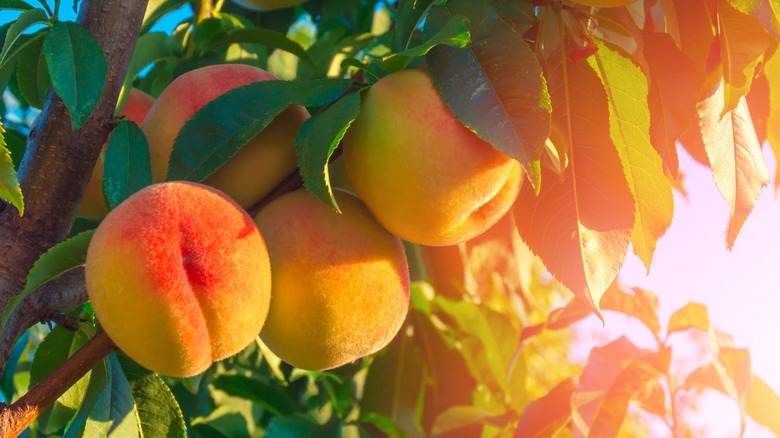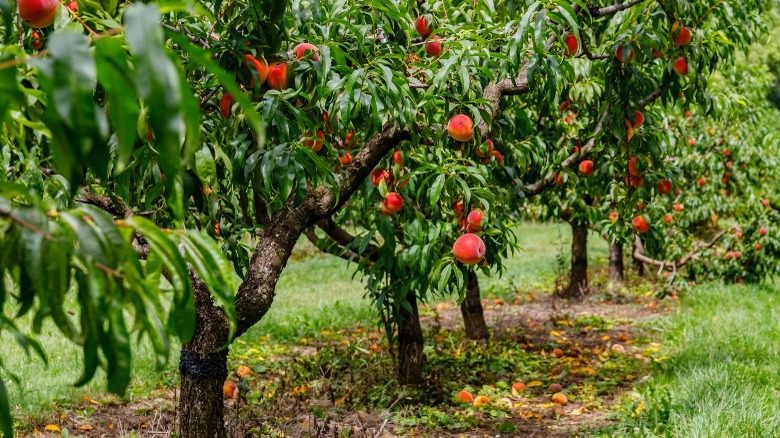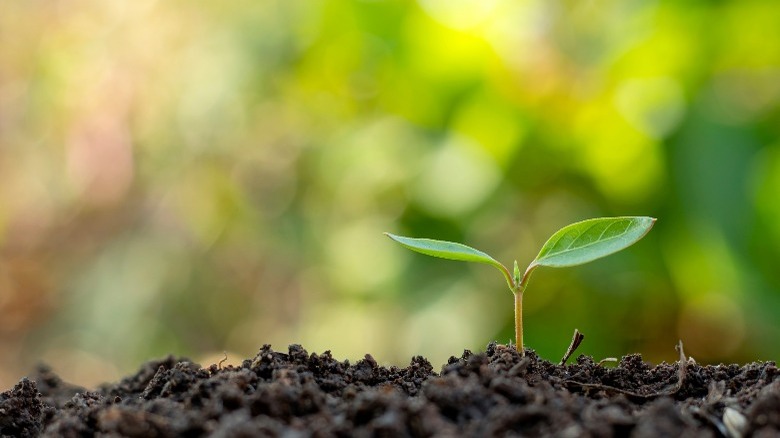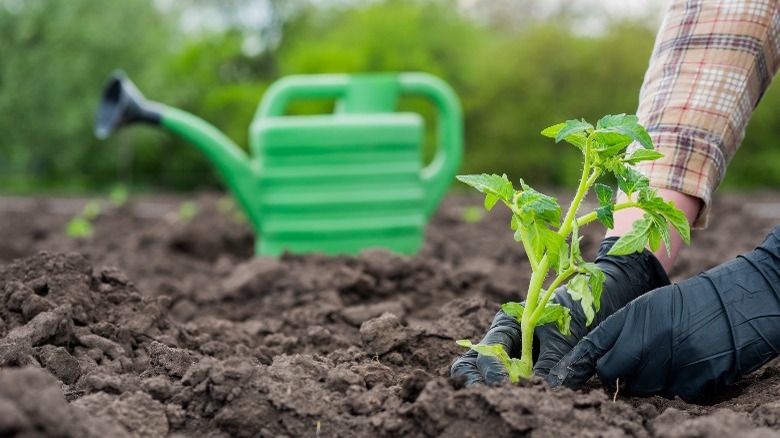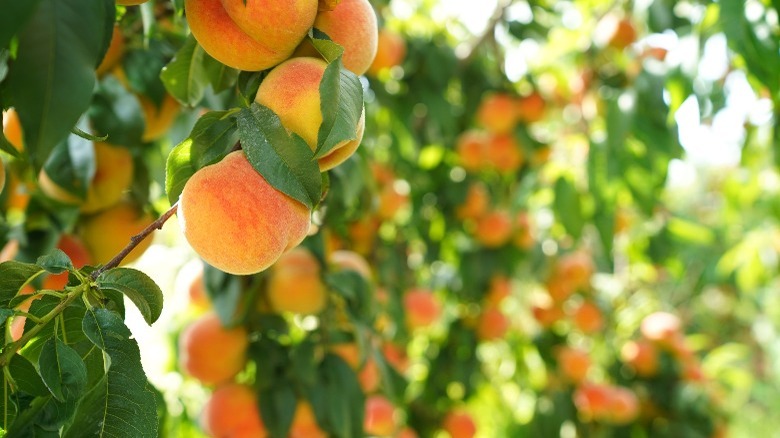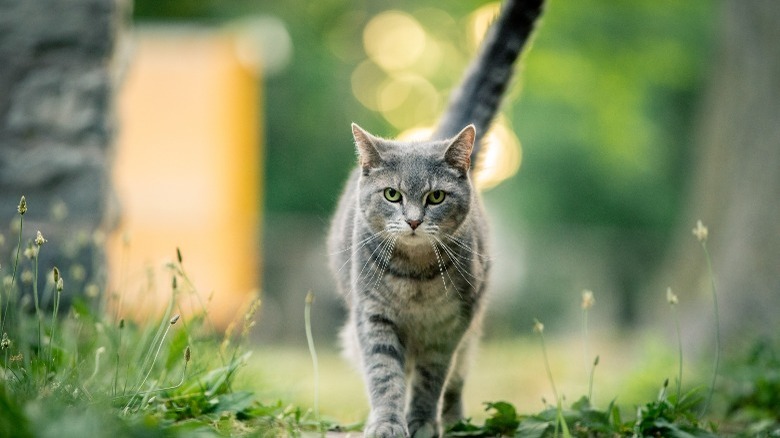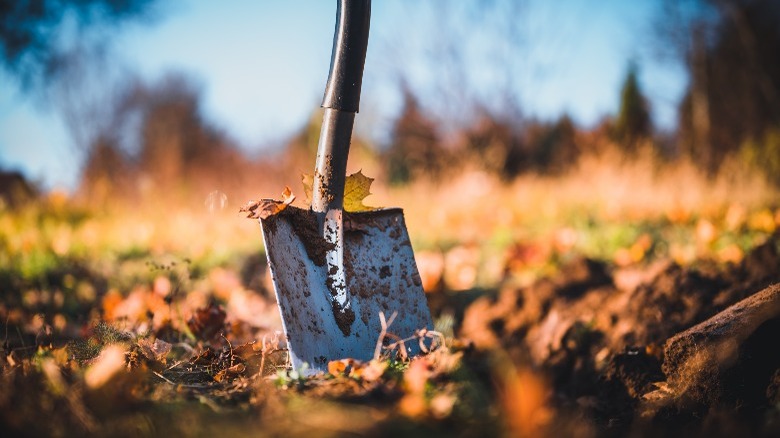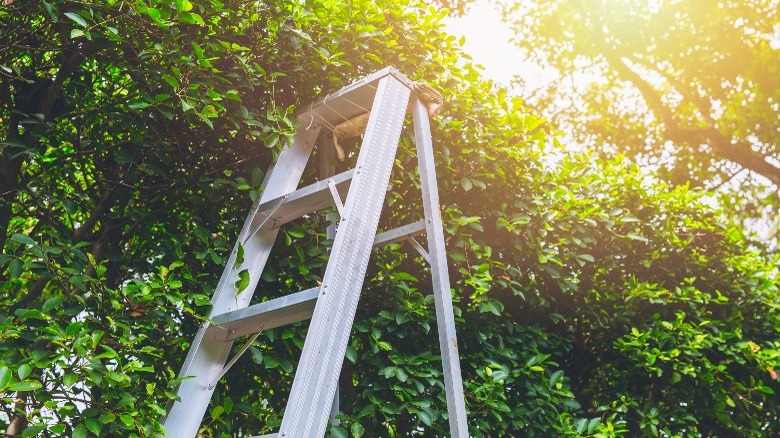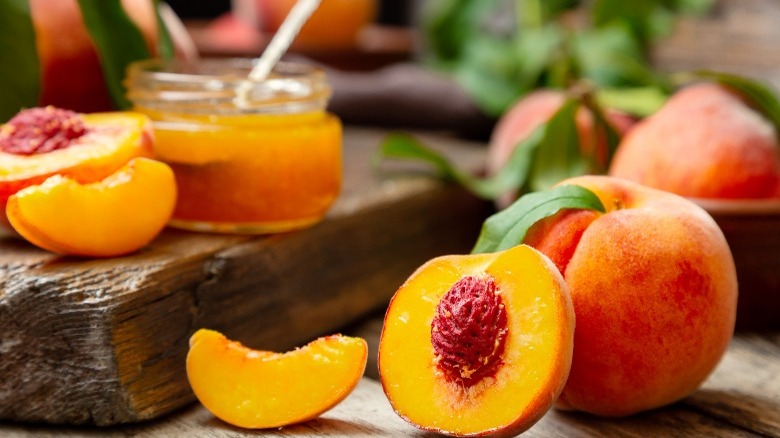How To Successfully Grow A Peach Tree
There are many different types of fruit trees found all around the world. One of the most popular types are peach trees; these trees are scientifically known as prunus persica trees and belong to the rose (rosaceae) family. According to Britannica, peach trees first originated in China, although how long ago is not fully known. They can typically be found in areas with warm climates and can live as little as eight years or well over 25 years, depending on the specific type.
Like most other trees, identifying peach trees is relatively easy. Depending on the specific type of tree, they can reach a height of about 20 feet if left unpruned. Home Stratosphere notes that young peach trees most likely have separated stems that form together into the trunk of the tree that are then separated by upward facing branches. For the most part, their leaves are typically bright green oval shaped with veins. As easy as it is identifying peach trees, growing and maintaining them are almost just as simple.
How to use a peach tree in garden
Luckily, peach trees are adaptable and can be grown in most places, including a garden. However, any other plants around where the peach tree should be considered. Other organisms that will eventually surround it are of importance as they'll both need space to grow. Planting anything too close together can cause the initial tree or other surrounding trees and plants to not grow as efficiently as desired. Peach trees can grow to be rather large if desired and will then throw a lot of shade. This might not be ideal for plants that need to be in full or even partial sunlight.
An important factor to consider is the other objects that will be around the peach tree. Any above ground or inground items such as wires, pipes, or other utility systems need to be known. This will prevent any unnecessary hassle, replanting, and wasted time. Remember to take into consideration that the tree will be a lot larger once fully grown. Stark Bro's recommends only starting with a few trees to begin with until a routine is established and more knowledge of these trees are developed.
How to grow a peach tree
One of the most important factors to consider is when and how to grow the peach tree. Almanac states that they should be planted and grown when they're at their dormant stage. Depending on the location, this usually happens late in the winter or early in the spring. They also recommend choosing a tree that is close to around a year old or even younger. Just like with humans and animals, older trees age and slowly become less healthy and may not be able to produce as often as younger trees. Choosing a younger tree will allow a longer lifespan and more production.
The peach tree should be planted in direct full sunlight so it receives all the nutrients from the sun it needs to grow up healthy. If unable to provide full sunlight, partial is okay, but the more sun the better. It is important to note that peach trees should not be fertilized when they are first planted, this will happen later on after the tree is comfortable. After establishing and successfully planting the tree, it should be watered immediately as the soil should be moist at all times.
How to care for a peach tree
After the peach tree is planted, now comes the part of taking care of it on a regular basis. For constant care, watering is the absolute most important thing so the new tree doesn't get dehydrated. Kellogg Garden suggests watering the new tree around three times a week to begin with. However, it may require more or less watering depending on location and rainfall in the area. As the tree begins to grow, it begins to require less watering and will only need to be watered on an as needed basis. Again, this also depends on the region and how much sunlight and rain the tree is receiving.
If the leaves are starting to turn brown and wilt, the tree is most likely dehydrated and should be watered immediately and more regularly. Give the tree time to gain color and form back and then resume the regular watering schedule. Remember to not over water and drown the tree. It only needs enough water to dampen the soil. More or less water can cause the tree to have a lesser life span.
Peach tree varieties
When first deciding to grow a peach tree, it's important to know what type of peach tree to get and the differences between them. It's evident that peach trees are grown primarily because of the fruit they produce. The exact type of peach decided should be the prime reason when choosing which type of tree to plant. As SFGate states, there are over 200 different types of peach trees in the entire world. Furthermore, the popularity of each type differs in each area. However, the two most popular and well known are white and yellow peach trees.
While there are clearly similarities between the two, let's focus on the differences. Per Pro Garden Tips, the primary difference in white peaches and yellow peaches comes down to taste. White peaches are perfect for those that want a sweet and juicier peach. Unlike white peaches, yellow peaches tend to be far more bitter and acidic. It's common for white peaches to be eaten fresh rather than baked because they have a much softer texture than yellow peaches. On the other hand, yellow peaches are great for baking desserts like peach cobbler.
Are peach trees toxic?
While there are many great health benefits to both peach trees and the fruit they produce, there are a few unfortunate downsides to growing and maintaining a peach tree as well. One of the most important things to consider when planting a fruit tree is insects and stray animals. The peaches that the tree produces have a strong scent that may lure in unwanted pests and creatures. While a raccoon most likely won't be wandering about during the day, insects aren't easily scared away. There is pesticide spray available to the public, but using this can cause the tree and fruit to become toxic to both humans and animals.
The peaches themselves, however, naturally come with actual toxic downsides. For starters, peaches can be toxic to pets, according to Intermountain Pet Hospital. While the peaches themselves aren't toxic, consumption of them is strongly not recommended as they can cause several digestion issues. However, the pit of the peach is extremely poisonous and should never be consumed. This con is extremely important to consider as fruits naturally fall from the tree, onto the ground, and possibly into your pet's grasp. This can be prevented by making sure all fallen fruit is picked up before allowing the pet outdoors.
How to replant a peach tree
If the time comes to uproot, move, and replant a tree, this must be done very carefully. Garden Guides highly recommends moving trees when they are dormant, which typically occurs during the winter months. Before digging up the tree, it's suggested to dig the new hole prior as it'll be easier to transfer the tree from one location to the next. It's also equally important to make sure the tree and its roots are soaked completely to allow for easier digging. Pruning beforehand can also make moving the tree more convenient as there will be less to move.
After removing the tree from its current home, it can then be planted in its new location. However, be extremely careful; since the tree was once planted and then dug up, it is now more fragile and at risk for broken roots. It should now be treated as a new tree and the above care instructions can be used.
Fertilizing and pruning a peach tree
Most don't realize that fruit trees actually don't require a lot of fertilization. According to Gardening Know How, the tree should be fertilized one week after the initial planting and again about six weeks later. After that, the tree should be fertilized in the early spring and again in the early summer. Additionally, the best type of fertilizer to get is one that has an equal balance of phosphorus, potassium, and nitrogen nutrients. It should be placed 8 inches to 12 inches away from the trunk in the amount of ½ of a cup. Add 1 pound each year until the tree is 5 years old. At this point and thereafter, this amount can be maintained for the remainder of the tree's life.
Pruning a peach tree is perhaps the hardest part of its maintenance. For the best results, The Spruce says to prune peach trees in the spring or shortly later and after the tree is at least 3 years of age. Some less excessive pruning may be required before then as well. To begin with, examine and remove any damaged or dead branches from the tree. There should be about three to five main branches of the tree to maintain balance and productivity. Trim and cut back all other branches and limbs, including tall ones to maintain the height desired. Much like the fertilizer, peach trees only need to be pruned once a year.
Health benefits of peaches
Like most fruits, peaches and the trees they come from have many health benefits as well. While most of the benefits come from the peaches themselves, there are a few notable mentions that come from the actual tree. Unlike the peaches, the tree itself can provide shade. This is a great perk that can help one have a cooler backyard that is perfect on a sunny day. It also can help one's yard be healthy as trees are naturally good for the environment, per the Arbor Day Foundation. Not to mention, if well-maintained, trees are super cute and can help any home become more attractive.
While trees have many benefits for the home and yard, peaches have benefits for one's health. The most well-known benefit is vitamins; according to Healthline, peaches are packed with vitamins A, B, C, E, K, along with several other minerals and antioxidants. They're also known to help with digestion, heart health, skin protection, cancer prevention, and allergies. Finally, peaches are a widely popular fruit, making then easily accessible and convenient to add to one's diet.
